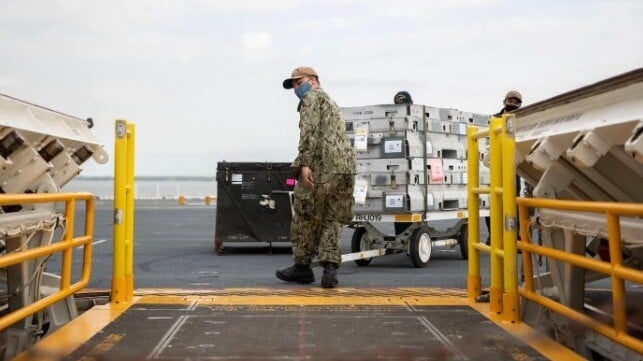After Four Years, All of USS Ford's Weapons Elevators Are Complete

The first-in-class carrier USS Gerald R. Ford has received a long-awaited present, just in time for Christmas. A joint Navy/contractor team has finished commissioning the last of the carrier's 11 weapons elevators, four years after the Navy took delivery of the ship.
“This is a significant milestone for the Navy, ship, and her crew,” said Rear Adm. James P. Downey, Program Executive Officer for Aircraft Carriers. “With completion of this final [elevator], we now have the entire system to operate and train with.”
Unlike the weapons elevators aboard previous generations of American carriers, Ford's are electromagnetically powered, and the technology behind them was not developed to maturity before installation. When the vessel was accepted for delivery 2017, none were functioning, meaning that the crew could not move munitions from the ship's magazines up to the flight deck. Shipbuilder Newport News delivered the first four upper-stage elevators to Ford by 2019, and the first of seven lower-stage elevators was finished in mid-2020.
As designed, the elevator systems have a high degree of complexity and require very precise tolerances during installation - a challenge in a traditional shipbuilding environment. That challenge has taken years of work and a team of outside expert advisors to fix. According to Downey, the effort "hundreds of craftsmen, technicians and engineers, working around the clock - through multiple underway and holiday periods - to get these advanced systems online and operational."
Like the Zumwalt-class destroyer and the twin Littoral Combat Ship classes, Ford was designed to take advantage of untested technologies, in keeping with Department of Defense priorities in the early 2000s. This approach to acquisition has resulted in protracted teething problems, including the problems with Ford's elevators, according to critics.
"The ammunition elevators are an exceptional example of a painful process over the past four or five years," said Chief of Naval Operations Adm. Mike Gilday in an interview in July. "We really shouldn’t introduce more than maybe one or two new technologies on any complex platform like that in order to make sure we keep risk at a manageable level. . . . [We need] a much more deliberate approach with respect to introducing new technologies to any platform."
